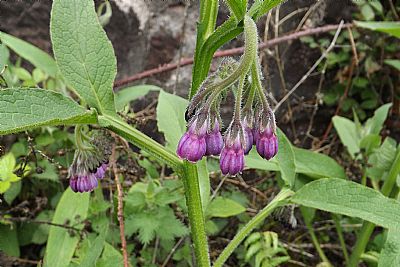COMMON COMFREY : Symphytum officinale
Note : Both cream flowered plants and blue/purple flowered plants are identified online as symphytum officinale. While we may be looking at hybrids, for our purposes, these are simply variations of the same plant.
Our example pictured below is from the road leading down to the Leven near the barrage. These attractive drooping tubular bell flowers are a creamy yellow with slightly darker tips. Yet the sources online refer to them being pink and illustrations show purple flowers. In spite of the contrasts in references, our example matches that on The Wildlife Trusts website.
The creamy yellow is the "original" native species. Those of other colours are still considered the same species, but have been altered through cross pollination over generations - such as by Russian species.
The flowers appear in early May and although rather small, hang in clusters which make them more conspicuous. Its leaves and stems are rather hairy. It thrives in damp ground such as near the Leven.
Some consider it a weed, but to others it is an important plant for organic gardening. Its roots reach deep into the soil making it rich in minerals. Its leaves aided by their hairy surfaces can be used for slug control and also as a fertiliser and as a composting aid.
The Wild Foods UK website simply says that it is a common and surprisingly tasty treat when battered and fried, but quickly adds that we need to consider other facts before consumption. See link below. For use both as food and medicinal remedies it notes :
Comfrey contains pyrrolizidine alkaloids some of which can harm the liver so some foragers no longer consider this a safe plant to eat but we still eat comfrey fritters from time to time as have many people with no obvious ill effects. Quantity is the key, a little every now and again is not likely to cause any harm. For more on this, refer to their website.
It is also noted that comfrey is frequently used in supplements sold commercially. The key here is that it is properly prepared. However it is not approved as a medical treatment by any authority, While many enjoy the benefits, there are also allergic to it. If you do purchase it, ensure that this is from a reputable source as contaminants such as metals and even other drugs are known to sometimes enter the production.

Low green clusters of leaves with small clusters of creamy yellow flowers. Picture taken near the Leven barrage.

New flowers in early May. Look closely and you will see the hairs on the leaves and stems.

These are also common comfrey. This picture was taken further down the Leven towards Alexandria.

It is even attractive when the flowers start to full apart.

It is two months since the peak flowering period for comfrey, but this one was found on the Leven towpath on the last day of July.
At the outset we noted that comfrey comes in variations of flower colour. The Wildlife Trusts illustrations on their website shows creamy yellow flowers much like the first two photos above. But their description their website says : The comfreys are a small group, but can be difficult to tell apart from each other as hybrids are common. Common comfrey has large, oval, hairy leaves, and clusters of drooping, tubular flowers that are pinky-purple in colour.
There are numerous varieties of comfrey, introduced and hybridised. These are described on the Horticulture Magazine website. Purple flowers are generally attributed to cross pollination with Russian varieties.
BRITISH NATURE GUIDE : http://www.britishnatureguide.com/common-comfrey-symphytum-officinale.html
HORTICULTURE MAGAZINE website : https://horticulture.co.uk/comfrey/varieties/
WILDFOODS UK : https://www.wildfooduk.com/edible-wild-plants/comfrey/
WILDLIFE TRUSTS : https://www.wildlifetrusts.org/wildlife-explorer/wildflowers/common-comfrey

